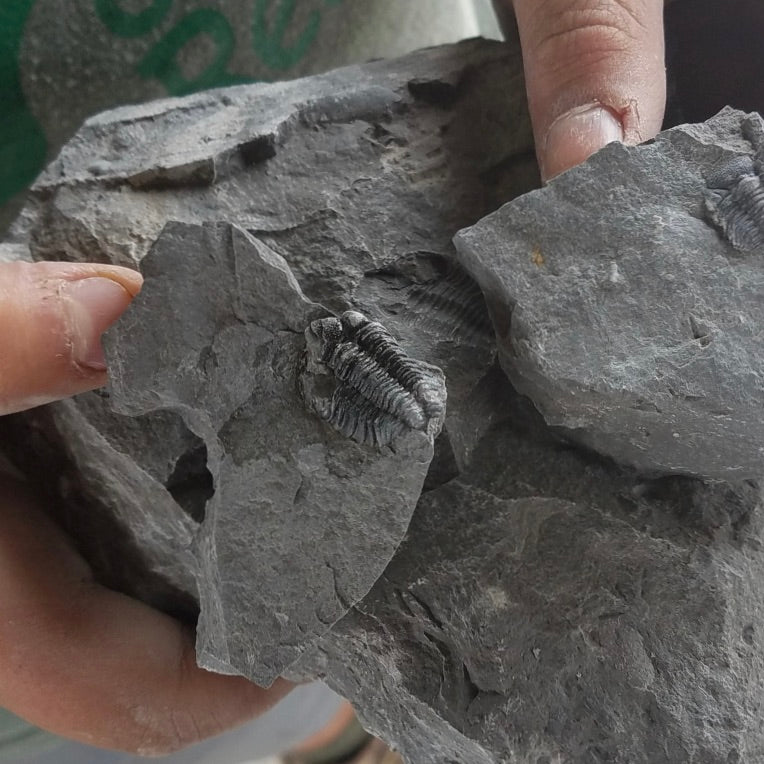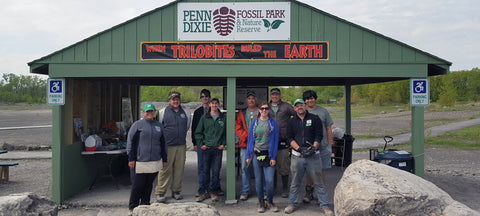If you’re interested in digging into — quite literally — New York State’s history, there’s no better place to explore than Western New York’s
Penn Dixie. Owned and operated by the Hamburg Natural History Society, Inc., and located in Blasdell (5 miles from the center of Hamburg, and 10 miles south of Buffalo), the Penn Dixie Paleontological and Outdoor Education Center is an internationally-known, hands-on fossil excavation site where the public can explore petrified remains of animals that lived 130 million years before the first dinosaurs. At this site in Erie County, one can meander through the grounds of the former Penn-Dixie Cement Company quarry. While in operation, calcareous shale used in the making of cement was extracted from this open-pit mine. When, in the 1960s, up to 10 feet of unearthed shale revealed 380 million-year-old fossils from the Devonian period (part of the Paleozoic era), the site was transformed, and by the early 1970s people started coming for the fossils. Penn Dixie is one of the only places in Western New York to legally hunt for fossils — in other words, there are other digging sites but permission must be granted beforehand. The
Geological Society of America ranked Penn Dixie as the No. 1 fossil park in the country in 2011. Yet, it still remains somewhat of a hidden gem, and even many locals are unaware of its existence.
The Hamburg Natural History Society was formed in 1993 with Penn Dixie in mind. The collaborators didn’t want to see Penn Dixie closed down, as was the fate of many other quarries due to liabilities. In 1995, the Town of Hamburg bought the 57-acre site and deeded 32.5 acres to the Society. With funding from the
East Hill Foundation (an organization that identifies and funds innovative projects that benefit the eight counties of Western New York) the society bought 16.75 adjacent acres in 2005. In 2008, five acres were added, bought with further grants and donations. Preliminary plans exist to build a $2 million outdoor center, the building of which would ensure the success of Penn Dixie’s year-long programming. According to
“New York Paleontology,” “New York State is the home for one of the most complete and well-studied sequences of Devonian strata in the world.” The “strata” was formed when the movement of tectonic plates collided present day North America with present day Western Europe. This shift formed a mountain range in present day Eastern New York, called the Acadian Mountains. As the mountains eroded, waterways carried a large amount of sediment away, covering land to the west. That sediment buried the hard remains of marine animals — trilobites, corals, crustacean, fish, gastropods and brachiopods — that lived on the ocean bottom of a shallow sea. Pressure over time changed sediment to rock, capturing the fossils inside.
Penn Dixie is a prime location for digging. Despite decades of excavation by roughly 100,000 diggers, visitors have barely scratched the surface; there’s no danger of “running out” of fossils for a long, long, long time. It’s easy to find them: simply turn rocks over, pluck them off the ground, or work with a hammer and chisel to carefully split them. A field trip haven, visitors will likely spot telltale yellow school buses parked on site. Penn Dixie has an outdoor educational facility where volunteers explain how fossils landed in the area and help those unfamiliar with fossil digs to find their footing. It’s not just all rocks, all the time. Bird watchers can spot more than 140 species of birds, including the Common Loon, the Great Blue Heron, the Rock Dove and the Eastern Bluebird, which happens to be New York’s State Bird. Since Penn Dixie is located away from the bright lights of the city (15 minutes South of Buffalo), it’s the perfect spot to star gaze during special programs. More information and visiting hours are available on the
website. For the cost to enter, you can dig to your heart’s content and keep whatever you find on the ground. Happy digging!
IF YOU GO
Penn Dixie Paleontological and Outdoor Education Center 4050 North Street Blasdell, New York 14219
May through October, the site is open to the public for fossil collecting: Saturdays, 9 AM - 4 PM Sundays, 11 AM to 4PM And has special hours during each year's Spring Break and Summer Vacation (June 14–Sept. 2, 2014): Mon.-Fri., 9 AM-4 PM, rain or shine. Closed Memorial Day, July 4 & Labor Day. Open Columbus Day, Monday, October 13, 9 AM-4 PM.
Admission Prices: Non-member adults: $7 Children 12 and under: $6 Children 2 and under: Free. Penn Dixie members: Free.




Leave a comment